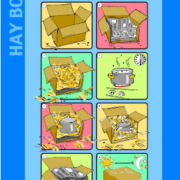Retained Heat Cooking

While at ARC we focus on how to cook most efficiently with biomass, it is good to remember that some cooking can continue without consuming fuel. A retained heat cooker (RHC), also known as a Haybox, is a great way to save on fuel for appropriate cooking tasks such as simmering rice or beans.
How does a retained heat cooker (RHC) help when cooking? When food simmers, the fire replaces the constantly lost heat from the pot. If the heat were not lost but captured instead, then less fuel would be needed for cooking. Placing the pot of boiling food in an insulated container keeps the food hot enough to simmer it to completion. In the same way, a drafty and uninsulated house has to have a big fire in the heating stove going all the time to keep the house warm. Even if no fire is lit, the super-insulated, almost airtight house can stay warm for a long time.
After a pot of food boils, the contents are close to 100°C. When the hot pot is placed in a super-insulated, almost airtight box, the food finishes cooking, because the stored heat stays in the food. Once the pot is in the box, food cooks without further attention. The retained heat cooker, saves time, effort, and fuel, freeing the cook from long hours of watching the slow fire when simmering food.
Approximately 50% savings in time and fuel savings can be expected. The rice or stew won’t burn and the cook can make dessert! Because the fuel is only used for boiling food, cooking with a Haybox creates much less pollution, helping to clean up the air in the kitchen. In tests of 18 stoves, using a retained heat cooker reduced, on average, CO emissions by 56% and PM emissions by 37% . (Test Results of Cook Stove Performance, 2011)
RHCs have been used for hundreds of years. They can save time and effort that can be devoted to other tasks. The attraction begins with convenience. The fuel savings and decrease in harmful emissions add to the benefits of retained-heat cooking. More information on Hayboxes can be found in the EPA’s “Guide to Designing Retained Heat Cookers.”




Leave a Reply
Want to join the discussion?Feel free to contribute!